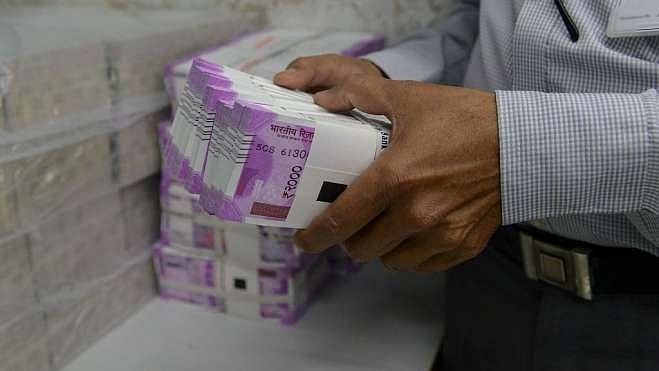Economy
It Doesn’t Matter If The bank Is Public Or Private, The Solution Lies In Efficient Management
- Post PNB fraud, there is a clamour for privatisation of public sector banks in India, but will it help?

A bank vault. (SAM PANTHAKY/AFP/GettyImages)
Since 1961 till date, under the provisions of the Banking Regulation Act, there have been as many as 81 bank amalgamations in the Indian banking system, of which 47 amalgamations took place before the first phase of nationalisation in July 1969. Out of the remaining 34 mergers, in 26 cases, the private sector banks were merged with public sector banks and in the remaining eight cases, both the banks were private sector banks. Therefore 26+8=34 private banks needed to be rescued through merger/amalgamation.
The process of merger and acquisition was gone through in many cases of Indian banking. Grindlays Bank merged with Standard Chartered Bank, Times Bank with HDFC Bank, Bank of Madura with ICICI Bank, Nedungadi Bank Ltd with Punjab National Bank and Global Trust Bank merged with Oriental Bank of Commerce. Merger and acquisition in Indian banking so far has been to provide safeguard and hedging weak bank against their failure.
GTB was involved in the stock market scam of 2001perpetrated by the stockbroker Ketan Parekh. GTB lent heavily to individuals speculating in the stock market; when the market crashed the bank suffered extensive losses.
The Reserve Bank of India examined GTB's accounts for 2001-2002 and found that GTB's net worth had turned negative, but did not close the bank. GTB did not address its problems. Instead, and despite its dire straits, GTB continued to expand. It had 87 branches in 2002-2003 and grew to 103 branches before the RBI forced it to close. It also paid interest on deposits at a rate equal to or better than other banks in its area.
Oriental Bank of Commerce (OBC) acquired GTB on 14 August 2004. Shareholders in GTB received nothing for their shares; depositors, however, suffered no loss. After acquiring GTB, OBC discovered that GTB's situation was even worse than it had appeared at the time of acquisition.
Global economic crisis which affected majority of the banks in United States of America had also resulted in bankruptcy of 18 Indian co-operative banks during the economic year 1 April 2008 till 31 March 2009.
All this shows that the track record of private banking in India is not without blemishes and it really calls for efficient management of the individual banks irrespective of it being in public sector or private sector.
A comparative analysis of 12 Indian banks was done in 2011 using DEA (Data Envelopment Analysis) method that included seven public sector banks and five new private sector banks. The multiple inputs considered for evaluation were equity capital, labour, loanable funds and the multiple outputs were net interest income, fee income. The data used for this analysis is the average of all the above-mentioned inputs and outputs over the period 2009-2011.
In this analysis, PNB occupies 2nd position and perhaps, if an analysis is done taking pre-fraud operational data thrown out by the core banking solution (CBS), it would still occupy a good position. Yet, the fraud occurred there and now if the liabilities crystallising post fraud are considered, it would occupy the worst position. It is therefore obvious that fraud was possible only because the transactions were off the record of the bank as the import finance module, if any and the SWIFT (Society for Worldwide Interbank Financial Telecommunication) were not integrated with the CBS.
The question that comes out now is in which other banks, public or private, such unintegrated working is being done and what all frauds would have occurred. This needs immediate looking into. The management of these identified banks along with their auditors would have to bear the responsibility for the wrong doings. This is of course over and above considering the individual official culpability. The other moot question is how did RBI the regulator, allow the unintegrated system to continue.
The management and the regulator are further responsible because the SWIFT provides for alert to the issuing bank and the regulator when the letter of undertaking is originated as well as when its receipt and lending against it are notified to the issuing bank by simply tagging the regulator.
The writer is a commentator and an author
Support Swarajya's 50 Ground Reports Project & Sponsor A Story
Every general election Swarajya does a 50 ground reports project.
Aimed only at serious readers and those who appreciate the nuances of political undercurrents, the project provides a sense of India's electoral landscape. As you know, these reports are produced after considerable investment of travel, time and effort on the ground.
This time too we've kicked off the project in style and have covered over 30 constituencies already. If you're someone who appreciates such work and have enjoyed our coverage please consider sponsoring a ground report for just Rs 2999 to Rs 19,999 - it goes a long way in helping us produce more quality reportage.
You can also back this project by becoming a subscriber for as little as Rs 999 - so do click on this links and choose a plan that suits you and back us.
Click below to contribute.
Latest